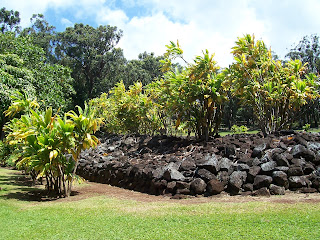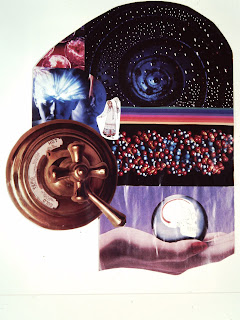I took my time and drove down to Nu’u Bay. I had been there a few years ago and had always intended to get back and spend
some time. There was a large village of fishermen that lived there at one time:
King Kekaulike and afterward, his son Kamehamehanui, both were in residence at
different times. I found the
petroglyph field easily and began photographing. Was it the light, the squall
that was brewing or the fact that the images had actually weathered that much
in just a few short years? Whatever the reason, they were worn—the whole place
was “worn”—just plum worn out. The sadness in the air, palpable. This particular petroglyph caught my
eye because it was the one that looked almost alive. Did its sense of being
alive come from the way it had been drawn on the rock—had the artist really
intended it to look so alien? Whatever it was, it stared at me with big round
eyes—and stared and stared. I could hardly bring myself to move; I was
transfixed for I don’t know how long.
I went on down to the rocky beach. The wind was whipping up
the waves and when I looked to the left, I saw the squall racing toward
me. I snapped a couple of pictures
and shoved my camera back in its case because the rain was upon me. In seconds
I was drenched. The keawe thicket
beckoned and I crawled under the branches to get out of the worst of the rain.
I stumbled through the grove until I found the trail again. I looked down and saw blood running down my arm, mixed with rainwater and sweat. It looks much more dramatic than it was. When I got back to the car, I wiped my arm off with a Starbucks napkin and examined the small nick I’d gotten from the keawe thorn. Yes, I had paid in blood, but it was a small price.
Every time I looked in my rear view mirror, I could see the squall chasing me up the coastline. I drove for a few miles and then stopped to take pictures of Kahaleamakani Gulch. The road crew had put up the rock nets to protect what few travelers venture into these parts. Although I understand the danger falling rock represents (and almost was the victim of a boulder on the road one night near Hanauma Bay), I still look at those nets as putting the rocks behind bars.
When I got to the other side of the Gulch and up to a pull-out, the wind
pushing the squall was right in my face. The closer I got to the edge of the
cliff, the stronger the updraft until it was all I could do to stand up in
order to take this picture. Below
there were lots of stone walls—windbreaks for the fishermen who camp down there in better weather. Just
that few minutes of picture taking and the squall had caught up with me again.
I looked over to the slopes of Haleakala—which are behind
the clouds that were scuttling along—seemingly as fast as I could drive. I knew that somewhere behind all those clouds
there was a 10,000 foot mountain.
This is a small section of the King’s Road. Every year, the
king would make his rounds of the island, collecting taxes. As I flew in from Honolulu, I was also
able to make out part of the king’s road around the Lahaina area. It’s easy to
see once you know what you’re looking for.
I had always wanted to find the petroglyphs behind Buzz’s
Steakhouse at Ma'alaea Bay. First I had to hop the traffic railing and wait
until both lines of traffic allowed me to scurry across the road. I walked
straight up the hill to the water tower. It was hot, the sun was beating down
on my head (I hadn’t worn a hat because I figured I’d just be fighting the wind
for my hat), and I had only a small bottle of water. The road went up at better
than a 25 degree angle and my old body felt it! I sat down and rested in the middle of the road, watching that same
squall coming up the coastline. I
found some petroglyphs, but I’m not entirely certain they are the ones I’ve
read about. Nonetheless, here is
one.
The next day I drove my friends up to the crater. Allison hadn’t been up there for years;
D, the old horseman, used to take the tourists down in the crater in 12 person
trail rides. At about 8,000 feet Allison
said she was feeling funny. By the time we got out of the car at a little over
10,000 feet, she was dizzy. We walked up the trail to the top of the rim. This
is the Kaupo Gap—the place the last lava flowed out of the crater. In the
distance is the Big Island—hidden in the clouds.
This is the Ko’olau Gap, the other flow went down the
windward side. When we were able
to sit down on the boulder and get out of the wind, we tarried long enough to
get a sense of the rarified air and the intense quiet (when the tourists
weren’t jabbering). I had a small bag of potato chips in the car, and the bag
swelled up with air until I thought for sure it would explode. I wanted to open
it up there—just to see what would happen—but D said, “You’d have chips
everywhere!” so I decided I’d watch the bag decompress on the way down. I was busy driving and forgot to look
until we were down to about 3,000 feet, and by that time it was almost back to
normal.

















































